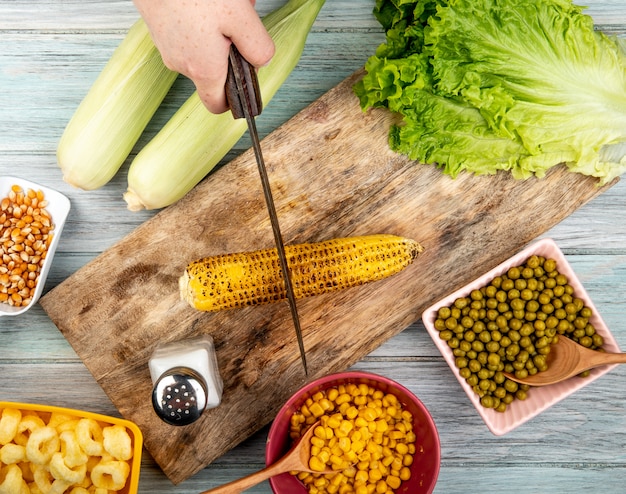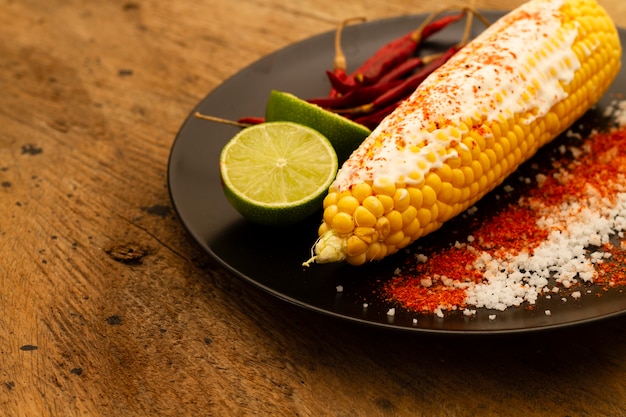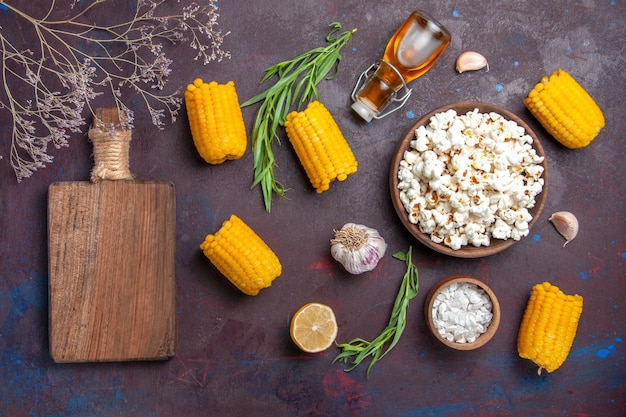Ah, the sweet scent of summer! The air is warm, the sun is shining, and the sound of laughter fills the air. And what better way to celebrate this glorious season than with a plate of perfectly cooked corn on the cob? But achieving that "oh-so-delicious" level of corn isn't always easy. Undercooked, overcooked, or bland – these are the pitfalls we all face. But fear not, my friends! I'm about to share my ultimate guide to perfect corn on the cob, a guide born from years of experimentation and countless culinary adventures. This guide will transform your perception of this humble summer staple. Trust me, it's going to be a game-changer.
My journey to perfect corn on the cob has been a long and winding one. From the smoky embrace of a charcoal grill to the gentle simmer of a pot of water, I've tried every method imaginable. I've even ventured into the realm of exotic corn varieties, exploring the unique flavours of purple, white, and even blue corn. It's been a delicious exploration, and I'm eager to share the secrets I've uncovered with you.
Part 1: Selecting the Perfect Corn

The pursuit of perfect corn on the cob begins with the right ingredients. It's like baking a cake – you wouldn't expect a delicious cake from a stale bag of flour, would you? So, how do you find the perfect corn? Let's dive into the details.
1.1 Look for Freshness:
First things first, check the husk. It should be bright green, tightly wrapped around the cob, and free from any brown or dry patches. This signifies fresh corn that hasn't been sitting around for too long. Now, bring your nose closer and take a whiff. You should be greeted by a sweet, slightly grassy aroma. If it smells stale or off-putting, walk away. Finally, give the cob a gentle squeeze. It should feel plump and firm, not soft or mushy. This indicates plump, juicy kernels.
1.2 Variety is the Spice of Life:
The world of corn offers a fascinating array of varieties, each with its own unique flavour and texture. I'm personally drawn to the sweet corn varieties like 'Silver Queen' and 'Golden Bantam' – they're incredibly sweet and juicy, a true delight. But don't be afraid to explore! Varieties like 'Shishito' or 'Purple Beauty' offer a slightly nutty or even buttery flavour. The beauty of corn is that there's a variety for every palate. Experiment and discover your favourite!
1.3 Seasonal Considerations:
When selecting corn, always aim to buy it during its peak season. Here in the UK, this generally falls between July and September. During these months, the corn is at its sweetest and most flavourful. If you're purchasing corn outside of this period, look for corn that has been properly stored to maintain its freshness. You might find that corn from warmer climates like Spain or Italy is available year-round.
Part 2: The Art of Prepping Corn

Now that you've got your perfect corn, it's time to prepare it for cooking. This stage is about getting rid of the husk and silks, and prepping your corn for a flavourful journey.
2.1 Husk and Silk Removal:
Removing the husk and silks is where things can get messy, but I've developed a foolproof method. First, gently pull the husk back, revealing the silks underneath. Now, grab a sharp knife and carefully cut off the tip of the husk. This will allow you to easily peel the husk back, removing the silks in one smooth motion. You can also use a pair of kitchen shears for this task. Once the husk is off, give the cob a quick rinse under cold water to remove any stray silks.
2.2 Alternative Methods:
If you're looking for a less messy way to remove the silks, there are alternatives. Some people like to soak the corn in cold water for a few minutes, which helps loosen the silks. You can also try removing the silks with a brush – this might sound a bit strange, but it works surprisingly well. Just use a stiff-bristled brush and gently brush the silks away.
2.3 Preparation for Cooking:
Before you start cooking, a bit of prep work can elevate your corn on the cob to new heights. Rub the corn with a bit of butter or oil. This encourages caramelization and adds extra flavour. You can also add a pinch of salt and pepper or experiment with herbs and spices. Personally, I love adding a sprinkle of smoked paprika or a dash of chili flakes for a touch of heat.
Part 3: Cooking Methods: Exploring the Possibilities

Here comes the exciting part – the cooking methods! There's a method for every taste and every kitchen. Let's explore some of the most popular options and their nuances.
3.1 Grilling: The Classic Approach
Grilling is the classic way to cook corn on the cob, and for good reason. The intense heat of the grill creates a beautiful char on the outside, while the steam trapped inside keeps the kernels juicy and tender. To grill corn, preheat your grill to medium heat. Place the corn on the grill, rotating every few minutes for even cooking. It's ready when the kernels are tender and the husk is slightly charred.
3.2 Boiling: The Simple and Reliable Option
For a quick and easy way to cook corn, boiling is a reliable choice. Simply fill a large pot with water, bring it to a boil, and add the corn. Cook for 5-7 minutes, or until the kernels are tender. Add a pinch of salt to the boiling water for extra flavour. Boiling is great for large groups as you can cook multiple ears at once.
3.3 Steaming: Retaining Moisture and Flavour
Steaming is a fantastic option for preserving the natural sweetness of the corn. Place the corn in a steamer basket and place the basket over a pot of boiling water. Steam for 5-7 minutes, or until the kernels are tender. You can also add herbs and spices to the water for extra flavour. I often like to add a bay leaf and some fresh thyme for a more aromatic steam.
3.4 Roasting: Achieving a Different Texture
roasting corn on the cob gives a slightly different texture. Preheat your oven to 400°F (200°C). Place the corn on a baking sheet and roast for 20-25 minutes, or until the kernels are tender. You can brush the corn with butter or oil before roasting for extra flavour. I like to add a sprinkle of coarse salt and black pepper before roasting. roasted corn has a slightly firmer texture than boiled or grilled corn, but it still has a delicious sweetness.
Part 4: Bringing out the Best in Corn: Seasoning and Serving
Once your corn is cooked, it's time to add the finishing touches. The way you season and serve your corn can make all the difference. Let's explore some ideas for elevating your corn on the cob experience.
4.1 Butter, Butter, Butter: The Classic Choice
Butter is a classic topping for corn on the cob for a reason. It melts beautifully over the hot kernels, adding a rich, creamy flavour. I like to use salted butter, as it brings out the sweetness of the corn. If you prefer, use unsalted butter and add a pinch of salt yourself. For an extra touch of indulgence, try flavoured butter, such as garlic butter or herb butter.
4.2 Spice It Up: Beyond the Butter
Don't be afraid to get creative with your seasonings. There's a whole world of flavour beyond butter. You can use a simple combination of salt and pepper, or get adventurous with spices like paprika, chili powder, or cumin. Add a sprinkle of herbs like parsley, cilantro, or chives. I love to shake things up with a tangy lime wedge, a sprinkle of cotija cheese, and a drizzle of hot sauce for a Mexican-inspired twist.
4.3 Salsas and Dips: A World of Flavour
For an extra layer of flavour, serve your corn with a side of salsa or dip. I love a classic pico de gallo or a creamy avocado salsa. You can also try a spicy salsa, a tangy salsa verde, or a creamy guacamole. If you're looking for something different, try a chipotle mayo or a garlic aioli. The options are endless!
4.4 Serving Corn with Style: Beyond the Plate
Corn on the cob is a versatile dish that can be served in many ways. While a simple plate is a classic option, there are other ways to present your corn. For a rustic look, try serving it on a wooden board or a rustic platter. You can also use a corn cob holder to keep your hands clean and mess-free. If you're serving a large group, consider using a corn cob stand to display the corn beautifully.
Part 5: Preserving the Sweetness: Freezing and Storing Corn
Corn on the cob is best fresh, but you can preserve it for later enjoyment. Whether you have a surplus of corn or simply want to enjoy it out of season, freezing or storing corn correctly can ensure its flavour and freshness are retained.
5.1 Freezing Corn for Future Use:
Freezing corn on the cob is a simple process that allows you to enjoy its sweetness throughout the year. First, blanch the corn by submerging it in boiling water for 3-5 minutes. Then, immediately plunge the corn into an ice bath to stop the cooking process. Once the corn is cool, remove the husk and silks. You can freeze the corn whole, or cut the kernels off the cob and freeze them in a freezer-safe bag. frozen corn can be stored for up to 12 months.
5.2 Storing Fresh Corn: Maintaining its Freshness
If you want to store fresh corn for a short period, wrap it in a damp paper towel and place it in a plastic bag. Store the bag in the refrigerator for up to 3 days. You can also store the corn in a sealed container filled with cold water. Change the water daily to keep the corn fresh. Remember that corn will start to lose its sweetness and flavour after a few days. For the best results, always try to cook fresh corn as soon as possible.
Part 6: Corn on the Cob: More Than Just a summer treat
While corn on the cob is often associated with summer barbecues and outdoor gatherings, it's a versatile ingredient that can be enjoyed year-round. Let's explore some creative ways to incorporate corn on the cob into your culinary repertoire.
6.1 Corn as a side dish: Endless Possibilities
Corn on the cob is a classic side dish, but don't be afraid to think outside the box. Serve it with grilled chicken, fish, or steak. It's also a great accompaniment to salads, soups, and stews. You can even add it to stir-fries or noodle dishes for a touch of sweetness and texture. The possibilities are endless!
6.2 Corn in Salads: Adding Sweetness and Crunch
Corn kernels can add sweetness and crunch to salads. You can add them raw, grilled, or roasted. I love to add corn kernels to a summery salad with tomatoes, cucumbers, and feta cheese. You can also combine corn with other ingredients, such as black beans, avocado, and cilantro, for a Mexican-inspired salad.
6.3 Corn in Soups and Stews: Adding Depth and Flavour
Corn kernels can add depth and flavour to soups and stews. You can add them whole or cut them into smaller pieces. I love to add corn to a creamy corn chowder or a hearty vegetable stew. Corn also pairs well with beans, potatoes, and other root vegetables. Its sweetness balances the savoury flavours of the other ingredients.
Part 7: Beyond the Cob: Exploring Corn's Versatility
Corn is a versatile ingredient that can be used in many ways beyond simply eating it off the cob. Let's explore some creative ways to use corn in your cooking.
7.1 Cornbread: A Southern Staple
Cornbread is a classic American dish made with cornmeal. It can be sweet or savory, and it's often served as a side dish with barbecue or chili. You can also use cornbread to make cornbread muffins, cornbread pudding, or even cornbread croutons. Cornbread is a great way to add a little bit of corn flavour to your meal.
7.2 Cornmeal: From Pancakes to Polenta
Cornmeal is a versatile ingredient that can be used to make a variety of dishes. It's commonly used to make pancakes, waffles, and muffins. You can also use cornmeal to make polenta, a creamy Italian dish made with cornmeal, water, and milk. Cornmeal is a great way to add texture and flavour to your dishes.
7.3 Corn Silk Tea: An Unexpected Beverage
You might be surprised to learn that corn silk can be used to make a tea. Corn silk tea is said to have a variety of health benefits, including diuretic, anti-inflammatory, and antioxidant properties. You can find corn silk tea bags at most health food stores. To make corn silk tea, simply steep the tea bags in hot water for 5-10 minutes.
Part 8: FAQs: Your Corn on the Cob Queries Answered
I've tried to cover everything, but if you still have questions about perfect corn on the cob, then here are some frequently asked questions and their answers to guide you.
8.1 What is the best way to store corn on the cob?
If you're planning to cook your corn within a day or two, store it in the refrigerator, wrapped in a damp paper towel and placed in a plastic bag. This helps retain moisture. Alternatively, you can store the corn in a sealed container filled with cold water, changing the water daily. However, the best option for longer storage is to freeze the corn.
8.2 How long does it take to cook corn on the cob?
The cooking time for corn on the cob varies depending on the method used. Grilling takes around 10-15 minutes, boiling takes about 5-7 minutes, steaming takes about 5-7 minutes, and roasting takes about 20-25 minutes. Always check the kernels for tenderness to ensure they are cooked through.
8.3 Can I eat the husk of corn on the cob?
It's best to remove the husk before cooking. The husk is tough and fibrous and won't be palatable. However, you can use the husk for other purposes, such as composting or making crafts.
8.4 Can you cook corn on the cob in the microwave?
Yes, you can cook corn on the cob in the microwave. Simply wrap the corn in a damp paper towel, place it on a microwave-safe plate, and microwave for 3-5 minutes, or until the kernels are tender. However, you might find that the kernels are not as evenly cooked as with other methods.
8.5 What are some healthy toppings for corn on the cob?
There are many healthy toppings for corn on the cob. Instead of butter, you can try using olive oil, avocado oil, or coconut oil. For flavour, you can use herbs like parsley, cilantro, or chives, spices like paprika, cumin, or chili powder, or a squeeze of lemon or lime juice. You can also add a sprinkle of nutritional yeast for a cheesy flavour.
So there you have it, my friends – the ultimate guide to perfect corn on the cob! Whether you're grilling, boiling, steaming, or roasting, these tips and tricks will ensure that your corn is a delicious highlight of any meal. Happy cooking!
Everyone is watching

Corn on the Cob: The Ultimate Guide to Perfectly Cooked Ears
Healthy MealsAh, corn on the cob. Just the name evokes images of sunny days, barbecues, and that sweet, juicy flavour that ...

Perfect Pork Roast Oven Cooking Time: A Guide to Delicious Results
Healthy MealsThere's something truly satisfying about a perfectly roasted pork. The aroma alone is enough to make your mout...

Ham Cooking Time: How Long to Bake, Smoke, or Boil a Delicious Ham
Healthy MealsAh, ham. It's a classic, isn't it? A real crowd-pleaser, especially around holidays. And when done right, it'...

Scallops: The Ultimate Guide to Perfect Cooking
Healthy MealsAh, scallops. Those delicate, sweet, and utterly delicious morsels of the sea. They hold a special place in my...

Spaghetti Squash: The Ultimate Guide to Cooking and Serving
Healthy MealsRemember that time you saw spaghetti squash at the supermarket, looking all bumpy and strange, and thought, "W...
